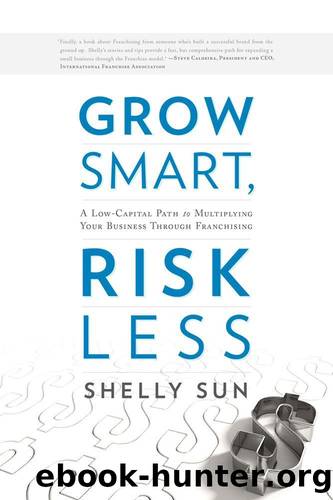Grow Smart, Risk Less: A Low-Capital Path to Multiplying Your Business Through Franchising by Sun Shelly

Author:Sun, Shelly [Sun, Shelly]
Language: eng
Format: epub
Publisher: Greenleaf Book Group
Published: 2011-10-15T16:00:00+00:00
The answer to question 1 above is $200,000. Using a 0.5 percent close rate to answer question 2, we need 6,000 leads (calculated using the 30 non-broker deals divided by the 0.5 percent close rate) to achieve 30 non-broker completions, and at $50 per suspect, the budget needed is $300,000 (calculated by multiplying the 6,000 suspects needed by the $50 cost per suspect). The budget of $200,000 will produce only 20 non-broker deals (calculated by dividing the $200,000 by $50 to determine the number of suspects that budget can generate, or 4,000 suspects, and then multiplying this by the 0.005 close rate). The answer to question 3, however, is that the CEO is expecting 30 non-broker deals and 10 broker deals for a total of 40 new franchisees. So 2 and 3 are out of alignment.
To resolve the discrepancy, either the non-broker goal needs to be reduced to 20 or the available lead generation budget needs to be increased. Likewise, the percentage of deals coming through brokers may need to be increased to achieve the goals, and new strategies may need to be developed to increase the number of broker deals. This could be a long shot, depending on past broker results, and this will impact the net deal income (franchise fees received less broker fees paid out) and the expectations that will need to be discussed.
I also recommend that your head of operations be consulted on the number of new franchisees planned for the year. This will assure you that the infrastructure is already in place, or that the company has planned for additional resources, to support the new franchisees while honoring commitments to your existing franchisees.
You may now be asking how you can determine the number of suspects you need. You can make some assumptions based on the number of non-broker deals you plan to close and conservatively assume you will need to generate 200 suspects (a 0.5 percent suspect-to-completion ratio) for every deal you want to close. Some systems are very successful with website leads, referrals, and public relations and therefore skew their suspect-to-completion ratio to 1 percent or 2 percent to offset the lower percentage that portals normally achieve. It is better to plan conservatively than to (1) wind up with idle salespeople who do not have enough suspects to have 25 to 35 active leads (CQ qualified) in their pipeline consistently; (2) fail to meet your growth goals that were communicated to your bank; or (3) fail to leverage the infrastructure put in place ahead of the planned growth.
Evaluating the Cost to Generate Leads
Most discussions about this topic focus only on two data points: the cost per suspect, which the industry refers to as the “cost per lead,” and the cost per completion, which the industry refers to as the “cost per sale.” For me, it’s important to evaluate lead sources and their ROI based on the following calculations:
Cost per suspect (or industry denoted “cost per lead")
Cost per CQ (or qualified lead)
Cost per completion (or
Download
This site does not store any files on its server. We only index and link to content provided by other sites. Please contact the content providers to delete copyright contents if any and email us, we'll remove relevant links or contents immediately.
| Consulting | Entrepreneurship |
| Franchises | Home Based |
| Marketing | New Business Enterprises |
| Nonprofit Organizations & Charities |
Pioneering Portfolio Management by David F. Swensen(6230)
Man-made Catastrophes and Risk Information Concealment by Dmitry Chernov & Didier Sornette(5926)
Zero to One by Peter Thiel(5691)
The Motivation Myth by Jeff Haden(5158)
The Miracle Morning by Hal Elrod(4640)
Elon Musk by Ashlee Vance(4034)
The Art of Persistence: Stop Quitting, Ignore Shiny Objects and Climb Your Way to Success by Michal Stawicki(3624)
Unlabel: Selling You Without Selling Out by Marc Ecko(3592)
Delivering Happiness by Tony Hsieh(3369)
Urban Outlaw by Magnus Walker(3342)
Purple Cow by Seth Godin(3143)
Mastering Bitcoin: Programming the Open Blockchain by Andreas M. Antonopoulos(2983)
The Marketing Plan Handbook: Develop Big-Picture Marketing Plans for Pennies on the Dollar by Robert W. Bly(2978)
The Power of Broke by Daymond John(2900)
The Content Trap by Bharat Anand(2863)
Applied Empathy by Michael Ventura(2839)
The Airbnb Story by Leigh Gallagher(2800)
Keep Going by Austin Kleon(2699)
Radical Candor by Kim Scott(2670)
